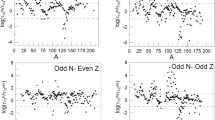Summary
Double beta-decay rates with and without two neutrinos are calculated for several nuclei by expressing the weak hadronic currents in terms of nuclear form factors which in turn are evaluated by use of the data on single β± decays of the intermediate nuclei. This approach leads to model-independent calculations of the neutrinoless double beta-decay ((0ν)ββ) amplitudes for the transitions 0+→1+ (ground state)→0+. Even though the results are not expected to exhaust the total amplitudes, they can be used in comparison with more conventional nuclear physics calculations to test the validity of such evaluations. It is also confirmed in our approach that the experimental data for (2ν)ββ decays of82Se and130Te are consistent with the assertion that the contribution of the 1+ lowest-lying state of the intermediate nucleus dominates in the (2ν)ββ amplitude.
Riassunto
Esprimendo le correnti deboli adroniche in termini di fattori di forma nucleari, calcoliamo per alcuni nuclei le ampiezze del doppio decadimento beta con e senza i due neutrini. I fattori di forma nucleari vengono valutati usando i dati sui singoli decadimenti β± dei nuclei intermedi. Questo metodo permette un calcolo indipendente dai modelli nucleari dell'ampiezza del doppio decadimento beta senza neutrini ((0ν)ββ) per le transizioni 0+→1+ (stato fondamentale)→0+. Anche se non ci si aspetta che i risultati forniscano l'ampiezza totale, questi possono essere confrontati con i risultati ottenuti dai calcoli di fisica nucleare per saggiarne la validità. Inoltre il nostro metodo conferma che i dati sperimentali per i decadimenti (2ν)ββ dei nuclei82Se e130Te sono consistenti con l'affermazione che il contributo dello stato 1+ di energia minore del nucleo intermedio domina nell'ampiezza dei decadimenti (2ν)ββ.
Резюме
Для некоторых ядер вычисляются интенсивности двойных бетараспадов с и без нейтрино, выражая слабые адронные токи в терминах ядерных форм-факторов, которые, в свою очередь, вычисляются с помощью данных о простых β± промежуточных ядер. Этот подход приводит к не зависящим от модели вычислениям ((0ν)ββ)-амплитуд безнейтринных двойных бета-распадов для переходов 0+→1+ (основное состояние)→0+. Полученные результаты при сравнении с обычными вычислениями ядерной физики могут быть использованы для проверки такого подхода. В нащем подхоле полученные результаты подгверждают, что экспериментальные данные для ((2ν)ββ)-распадов82Se и130Te согласуются с утверждением, что вклад низко-лежащего состояния 1+ промежуточного ядра является доминируюшим в ((2ν)ββ)-амплитуде.
Similar content being viewed by others
References
H. Primakoff andS. P. Rosen:Ann. Rev. Nucl. Part. Sci.,31, 145 (1981);W. C. Haxton andG. J. Stephenson jr.:Prog. Part. Nucl. Phys.,12, 409 (1984);M. Doi, T. Kotani andE. Takasugi:Prog. Theor. Phys. Suppl.,83, 1 (1985);J. D. Vergados:Phys. Rep.,133, 1 (1986).
S. R. Elliott, A. A. Hahn andM. K. Moe:Phys. Rev. Lett.,59, 2020 (1987).
D. O. Caldwell, R. M. Eisberg, D. M. Grumm, M. S. Witherel, F. S. Goulding andA. R. Smith:Phys. Rev. Lett.,59, 419 (1987);S. R. Elliott, A. A. Hahn andM. K. Moe:Phys. Rev. C,36, 2129 (1987) andPhys. Rev. Lett.,59, 1649 (1987);F. T. Avignone III, R. L. Brodzinski, H. S. Miley andJ. H. Reeves:Phys. Lett. B,198, 253 (1987). For a review on the perspectives of new experimental methods in ββ decays see, for example:E. Fiorini:Review talk given at the Eight Workshop on Grand Unification (Syracuse, April 1987).
P. Vogel andM. R. Zirnbauer:Phys. Rev. Lett.,57, 3148 (1986).
O. Civitarese, A. Faessler andT. Tomoda:Phys. Lett. B,194, 11 (1987).
K. Muto andH. V. Klapdor: preprint (October 1987).
W. M. Alberico, M. B. Barbaro, A. Bottino andA. Molinari: to appear inAnn. Phys. (N.Y.).
T. Tomoda andA. Faessler:Phys. Lett. B,199, 475 (1987).
J. Engel, P. Vogel andM. R. Zirnbauer:Phys. Rev. C,37, 731 (1988).
K. Grotz, H. V. Klapdor andJ. Metzinger:J. Phys. G,9, L169 (1983).
J. Abad, A. Morales, R. Núñez-Lagos andA. F. Pacheco:J. Phys. (Paris) C,3, 147 (1984).
C. W. Kim andH. Primakoff:Phys. Rev. B,140, 566 (1965) andMesons in Nuclei, edited byM. Rho andD. H. Wilkinson, 1979) p. 79.
A. Bottino, G. Ciocchetti andC. W. Kim:Phys. Rev. C,9, 2052 (1974).
A. Bottino andG. Ciocchetti:Nucl. Phys. A,178, 593 (1972).
K. Grotz andH. V. Klapdor:Nucl. Phys. A,460, 395 (1986).
Nuclear Data Sheets, edited by Nuclear Data Group,51, 95 (1987).
Nuclear Level Schemes A=45 through A=257 from Nuclear Data Sheets, edited by Nuclear Data Group (Academic Press, New York, N.Y., 1973).
Table of Isotopes, edited byC. M. Lederer andV. S. Shirley (J. Wiley, New York, N.Y., 1978).
O. K. Manuel:Proceedings of the International Symposium on Nuclear Beta Decays and Neutrino, edited byT. Kotani, H. Ejiri andE. Takasugi (World Scientific, Singapore, 1986), p. 71.
T. Kirsten, E. Heusser, D. Kaether, J. Oehm, E. Pernicka andH. Richter:Proceedings of the International Symposium on Nuclear Beta Decays and Neutrino, edited byT. Kotani, H. Ejiri andE. Takasugi (World Scientific, Singapore, 1986), p. 81.
Author information
Authors and Affiliations
Additional information
Переведено редакцией.
Rights and permissions
About this article
Cite this article
Bottino, A., Giunti, C. & Kim, C.W. Calculation of double beta-decay rates using nuclear form factors. Nuov Cim A 100, 941–952 (1988). https://doi.org/10.1007/BF02789012
Received:
Published:
Issue Date:
DOI: https://doi.org/10.1007/BF02789012



